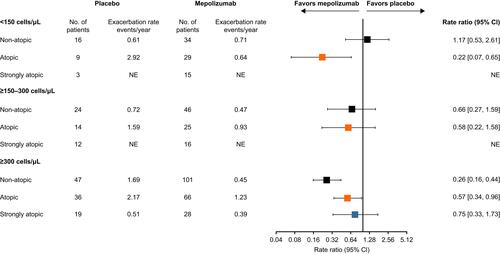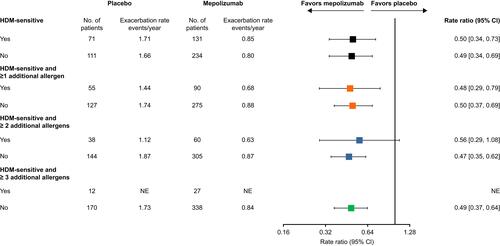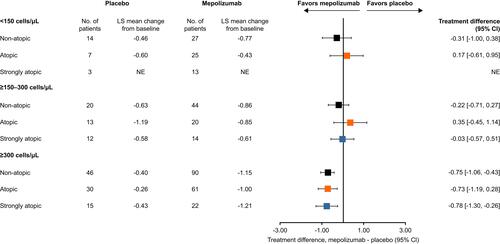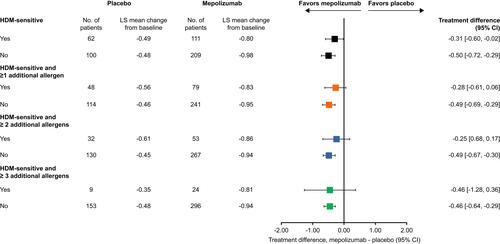Figures & data

Table 1 Patient Baseline Demographics and Clinical Characteristics
Figure 1 Rate ratios for clinically significant exacerbations by atopy/baseline blood eosinophil count status. Atopy was defined according to sensitization to any one of the following allergens: A. alternata, cockroach, HDM, cat dander and dog dander. Non-atopic: class 0 (IgE <0.35 kU/L); atopic: classes 1, 2 and 3 (IgE ≥0.35–17.5 kU/L); strongly atopic: classes 4, 5 and 6 (IgE >17.5 kU/L).

Figure 2 Rate ratios for clinically significant exacerbations by HDM sensitivity. HDM-sensitive (classes 1–6: IgE ≥0.35 kU/L to D. farinae and/or D. pteronyssinus) or HDM non-sensitive (class 0: IgE <0.35 kU/L to D. farinae and/or D. pteronyssinus). Within these categories, patients were grouped according to sensitivity to other allergens (A. alternata, cockroach, cat dander or dog dander; classes 1–6: ≥0.35 kU/L) to ≥1, ≥2 or ≥3 additional allergens.

Figure 3 Change from baseline in ACQ-5 score at Week 32 by atopy and baseline blood eosinophil count categories. Atopy was defined according to sensitization to any one of the following allergens: A. alternata, cockroach, HDM, cat dander and dog dander. Non-atopic: class 0 (IgE <0.35 kU/L; atopic: classes 1, 2 and 3 (IgE 0.35–17.5 kU/L); strongly atopic: classes 4, 5 and 6 (IgE 17.6–>100 kU/L).

Figure 4 Change from baseline in ACQ-5 score at Week 32 by HDM sensitivity. HDM-sensitive (classes 1–6: IgE ≥0.35 kU/L to D. farinae and/or D. pteronyssinus) or HDM non-sensitive (class 0: IgE <0.35 kU/L to D. farinae and/or D. pteronyssinus). Within these categories, patients were grouped according to HDM sensitivity (classes 1–6: ≥0.35 kU/L) and to additional allergens (ie ≥1, ≥2 or ≥3 additional allergens; A. alternata, cockroach, cat dander or dog dander).

